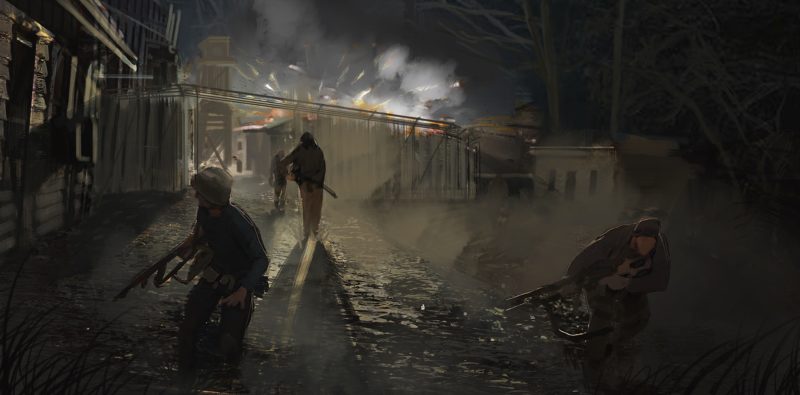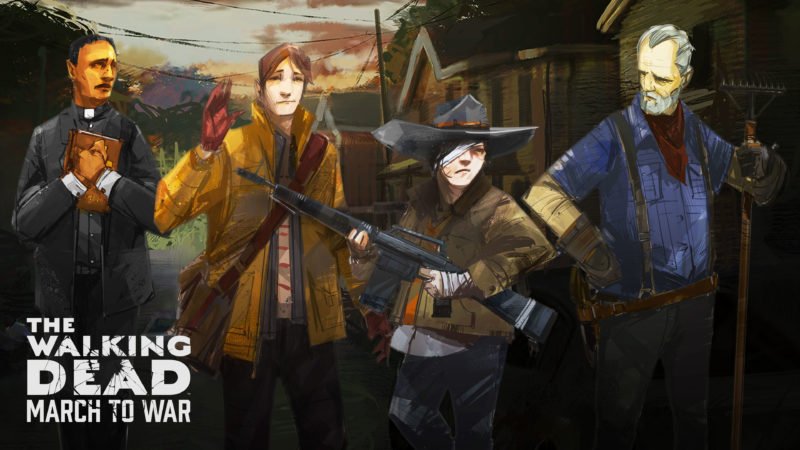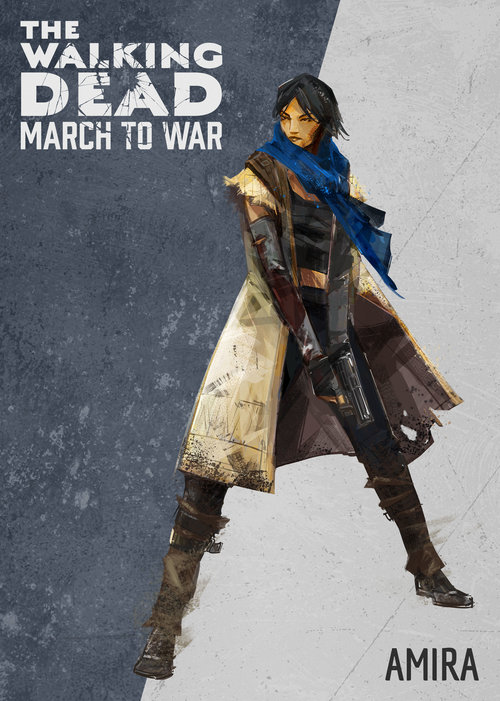Like all Disruptor Beam games, THE WALKING DEAD: MARCH TO WAR is deeply story driven, immersing you in the narrative of your chosen game. From the stories you play through to the artwork created for the game (like the Mission Art in this post), we want you to lose yourself in the worlds our games inhabit. Here, Lead Narrative Designer and storyteller extraordinaire Jessica Sliwinski talks about how she developed the main game narrative for THE WALKING DEAD: MARCH TO WAR.
What inspired The Walking Dead: March to War? How did you approach adding a new chapter to the world of The Walking Dead?
Fans of both the comics and the show have all surely had this experience: you’re reading or watching along, you see Rick make a decision, you turn the page or blink… and suddenly a beloved character is dead as a result! You find yourself playing armchair apocalypse leader, saying, “I would never have done that! What Rick should have done, which would have avoided this whole mess, was X….” That shared experience was the seed that would grow into The Walking Dead: March to War: if you were Rick, what would you do? How would you survive? Could you live with your decisions? Or would you die by them?
To create an authentic world in which players could answer these questions, we went straight to the source: Skybound, home of The Walking Dead comic book series. Skybound has been an enthusiastic and passionate partner, helping us to ensure that our representations of beloved canon characters are true to who they are in the comics, as well as the stories we tell are in keeping with the series’ overall themes.
In the context of the comics, when does The Walking Dead: March to War take place?
As the name suggests, The Walking Dead: March to War takes place shortly before the events of Volume 20, “All Out War.” Several key catalysts for the war have occurred (spoilers!); Abraham and Glenn’s deaths, Negan’s increased demands on Alexandria as well as other communities, Rick having met and formed an alliance with the Hilltop and the Kingdom against the Saviors. The powderkeg is about to explode… and then a horde of walkers arrives. This horde surrounds the D.C. area, trapping these four communities together along with many new independent ones. From there, The Walking Dead: March to War becomes a bit of an alternate universe. If an external threat like the horde as well as many new potential allies (or enemies) suddenly showed up, how might that delay or otherwise impact the war against the Saviors? What would Rick and Negan’s new strategies be? As a newcomer with no horse in this race, how does the Player fit in?
Who am I, in the world of The Walking Dead: March to War? What’s my relationship with people like Rick and Negan?
You are the leader of your own growing community. Though you’ve got a ways to go before you command the numbers that Rick or Negan do, it’s clear even in your early days that you are a force to be reckoned with, people are drawn to you, you are building something worth defending—to the death, if necessary. Both Rick and Negan, among others, see these qualities in you and recognize that you could either be a great asset or a serious threat in the bigger war to come. They will try to win you over to their side, but it will ultimately be up to you who will sit on your Council and be trusted to advise you against your many fellow upstarts.
In terms of the game narrative, what does it mean to have a character on my Council?
Members of your Council are individuals who have come to trust you, at least enough to visit your community on a regular basis and fight alongside your survivors. You can continue to build your relationship with each of them by completing their Council Story: a sort of side quest chain which revolves around getting to know that Council member and completing objectives of personal importance to them. While most available Council members are canon characters who permanently reside in places like Alexandria and the Hilltop, there is one Council member who is part of your community from the very beginning: Amira.
Who is Amira? Is she an existing character, or new to the game?
Amira is an original character, created by the Disruptor Beam team exclusively for The Walking Dead: March to War. You and Amira meet in the very first moments of the game, and form an instant bond by saving each other’s lives. Amira will become your right hand woman and earliest advisor, informed by her deep knowledge of the D.C. area as a local resident before the dead started walking. Thanks to her father, a former staffer in a diplomat’s office, Amira is well-educated and knowledgeable about the politics of war, but also young and ambitious, sometimes to a fault. Like so many survivors, Amira had nothing to lose before meeting you and helping you form your new community, and she will fight to defend it. In creating Amira, we wanted to add a character to The Walking Dead pantheon who could both stand as an equal and stand apart as a unique archetype. To say any more would ruin the fun of getting to know Amira in-game, so we’ll leave it there!
Are there any game systems or features in particular in which narrative plays a key role?
Both the Objective system and the Council Story systems are the main “containers” of narrative; the Objective system will help you develop your community and tell the larger story of The Walking Dead: March to War, while Council Stories, as mentioned above, allow you to develop your individual relationships with important characters. But narrative is present in many other game systems as well. Each Survivor you recruit has a unique backstory as well as a unique situation in which they are acquired. You’ll watch your community grow from a cluster of tents and cars to permanent structures made of brick and steel. Each time you send a party out, you can watch them move across the map, take action when they reach their destination, then return home—at least, the ones who survived the trip.
What is it like writing for a war game? How does it differ from writing for a genre more traditionally story-focused?
At Disruptor Beam, we are story-focused no matter the genre. It’s stories that drive games, and which drive fan interest in playing games. When it comes to a war game like The Walking Dead: March to War, the story of the game largely writes itself, through the battles you choose to have or avoid, the victories and losses that mount from day to day, and the deep rivalries that come as a result. The narrative designer’s job then becomes determining how best to support this emergent storytelling, and ensuring that any linear story also present in the game both enhances and drives the core gameplay loops (as opposed to distracting from them.) While there are many hand-crafted narratives within The Walking Dead: March to War, from getting to know iconic characters like Michonne and Andrea to guiding your newborn community through its first meeting with the Saviors, ultimately the best stories in the game will be written in blood on the battlefield. We can’t wait to release the game so we can see how they’ll play out!
THE WALKING DEAD: MARCH TO WAR comes to mobile devices soon! To make sure you’re receiving the most up-to-date information about the game, join the Survivor’s List and follow us on Facebook, Twitter and Instagram.
Related: The Walking Dead: March to War Council System Revealed
I have always enjoyed playing video games and am a programming team lead for a video game company. I co-founded Gaming Cypher because I enjoy the gaming community and would like to provide the best news service around. Feel free to ask me any questions and I will make sure to get back to you quickly.








More Stories
Red Dead Redemption and Undead Nightmare Available Now on Netflix, PS5, Xbox Series X|S, iOS, Android, and Nintendo Switch 2
Cult of the Lamb Heading to Mobile via Apple Arcade on December 4
Zynga Wraps Up its Inaugural Mentorship Program, an Exciting Partnership with the Black Zynga Union and eSports Youth Club